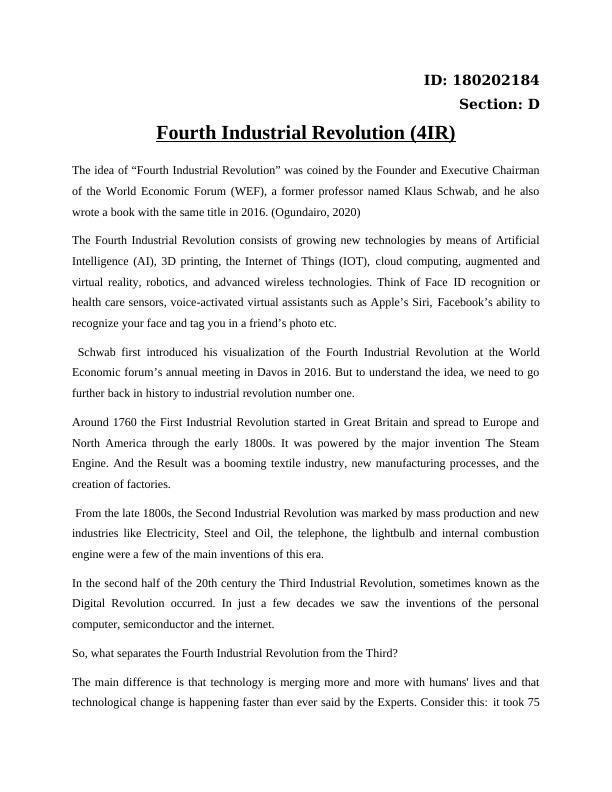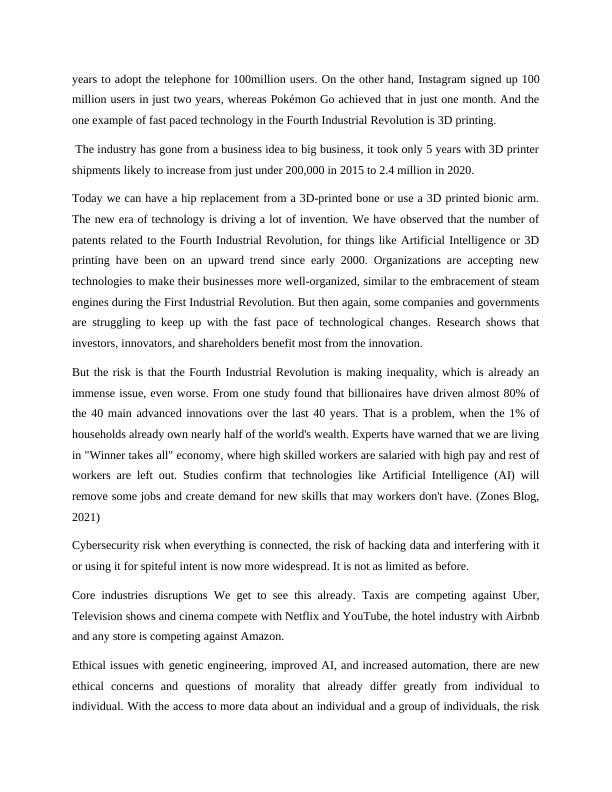What Is the Fourth Industrial Revolution?
4 Pages1114 Words18 Views
Added on 2022-09-06
What Is the Fourth Industrial Revolution?
Added on 2022-09-06
ShareRelated Documents
ID: 180202184
Section: D
Fourth Industrial Revolution (4IR)
The idea of “Fourth Industrial Revolution” was coined by the Founder and Executive Chairman
of the World Economic Forum (WEF), a former professor named Klaus Schwab, and he also
wrote a book with the same title in 2016. (Ogundairo, 2020)
The Fourth Industrial Revolution consists of growing new technologies by means of Artificial
Intelligence (AI), 3D printing, the Internet of Things (IOT), cloud computing, augmented and
virtual reality, robotics, and advanced wireless technologies. Think of Face ID recognition or
health care sensors, voice-activated virtual assistants such as Apple’s Siri, Facebook’s ability to
recognize your face and tag you in a friend’s photo etc.
Schwab first introduced his visualization of the Fourth Industrial Revolution at the World
Economic forum’s annual meeting in Davos in 2016. But to understand the idea, we need to go
further back in history to industrial revolution number one.
Around 1760 the First Industrial Revolution started in Great Britain and spread to Europe and
North America through the early 1800s. It was powered by the major invention The Steam
Engine. And the Result was a booming textile industry, new manufacturing processes, and the
creation of factories.
From the late 1800s, the Second Industrial Revolution was marked by mass production and new
industries like Electricity, Steel and Oil, the telephone, the lightbulb and internal combustion
engine were a few of the main inventions of this era.
In the second half of the 20th century the Third Industrial Revolution, sometimes known as the
Digital Revolution occurred. In just a few decades we saw the inventions of the personal
computer, semiconductor and the internet.
So, what separates the Fourth Industrial Revolution from the Third?
The main difference is that technology is merging more and more with humans' lives and that
technological change is happening faster than ever said by the Experts. Consider this: it took 75
Section: D
Fourth Industrial Revolution (4IR)
The idea of “Fourth Industrial Revolution” was coined by the Founder and Executive Chairman
of the World Economic Forum (WEF), a former professor named Klaus Schwab, and he also
wrote a book with the same title in 2016. (Ogundairo, 2020)
The Fourth Industrial Revolution consists of growing new technologies by means of Artificial
Intelligence (AI), 3D printing, the Internet of Things (IOT), cloud computing, augmented and
virtual reality, robotics, and advanced wireless technologies. Think of Face ID recognition or
health care sensors, voice-activated virtual assistants such as Apple’s Siri, Facebook’s ability to
recognize your face and tag you in a friend’s photo etc.
Schwab first introduced his visualization of the Fourth Industrial Revolution at the World
Economic forum’s annual meeting in Davos in 2016. But to understand the idea, we need to go
further back in history to industrial revolution number one.
Around 1760 the First Industrial Revolution started in Great Britain and spread to Europe and
North America through the early 1800s. It was powered by the major invention The Steam
Engine. And the Result was a booming textile industry, new manufacturing processes, and the
creation of factories.
From the late 1800s, the Second Industrial Revolution was marked by mass production and new
industries like Electricity, Steel and Oil, the telephone, the lightbulb and internal combustion
engine were a few of the main inventions of this era.
In the second half of the 20th century the Third Industrial Revolution, sometimes known as the
Digital Revolution occurred. In just a few decades we saw the inventions of the personal
computer, semiconductor and the internet.
So, what separates the Fourth Industrial Revolution from the Third?
The main difference is that technology is merging more and more with humans' lives and that
technological change is happening faster than ever said by the Experts. Consider this: it took 75

years to adopt the telephone for 100million users. On the other hand, Instagram signed up 100
million users in just two years, whereas Pokémon Go achieved that in just one month. And the
one example of fast paced technology in the Fourth Industrial Revolution is 3D printing.
The industry has gone from a business idea to big business, it took only 5 years with 3D printer
shipments likely to increase from just under 200,000 in 2015 to 2.4 million in 2020.
Today we can have a hip replacement from a 3D-printed bone or use a 3D printed bionic arm.
The new era of technology is driving a lot of invention. We have observed that the number of
patents related to the Fourth Industrial Revolution, for things like Artificial Intelligence or 3D
printing have been on an upward trend since early 2000. Organizations are accepting new
technologies to make their businesses more well-organized, similar to the embracement of steam
engines during the First Industrial Revolution. But then again, some companies and governments
are struggling to keep up with the fast pace of technological changes. Research shows that
investors, innovators, and shareholders benefit most from the innovation.
But the risk is that the Fourth Industrial Revolution is making inequality, which is already an
immense issue, even worse. From one study found that billionaires have driven almost 80% of
the 40 main advanced innovations over the last 40 years. That is a problem, when the 1% of
households already own nearly half of the world's wealth. Experts have warned that we are living
in "Winner takes all" economy, where high skilled workers are salaried with high pay and rest of
workers are left out. Studies confirm that technologies like Artificial Intelligence (AI) will
remove some jobs and create demand for new skills that may workers don't have. (Zones Blog,
2021)
Cybersecurity risk when everything is connected, the risk of hacking data and interfering with it
or using it for spiteful intent is now more widespread. It is not as limited as before.
Core industries disruptions We get to see this already. Taxis are competing against Uber,
Television shows and cinema compete with Netflix and YouTube, the hotel industry with Airbnb
and any store is competing against Amazon.
Ethical issues with genetic engineering, improved AI, and increased automation, there are new
ethical concerns and questions of morality that already differ greatly from individual to
individual. With the access to more data about an individual and a group of individuals, the risk
million users in just two years, whereas Pokémon Go achieved that in just one month. And the
one example of fast paced technology in the Fourth Industrial Revolution is 3D printing.
The industry has gone from a business idea to big business, it took only 5 years with 3D printer
shipments likely to increase from just under 200,000 in 2015 to 2.4 million in 2020.
Today we can have a hip replacement from a 3D-printed bone or use a 3D printed bionic arm.
The new era of technology is driving a lot of invention. We have observed that the number of
patents related to the Fourth Industrial Revolution, for things like Artificial Intelligence or 3D
printing have been on an upward trend since early 2000. Organizations are accepting new
technologies to make their businesses more well-organized, similar to the embracement of steam
engines during the First Industrial Revolution. But then again, some companies and governments
are struggling to keep up with the fast pace of technological changes. Research shows that
investors, innovators, and shareholders benefit most from the innovation.
But the risk is that the Fourth Industrial Revolution is making inequality, which is already an
immense issue, even worse. From one study found that billionaires have driven almost 80% of
the 40 main advanced innovations over the last 40 years. That is a problem, when the 1% of
households already own nearly half of the world's wealth. Experts have warned that we are living
in "Winner takes all" economy, where high skilled workers are salaried with high pay and rest of
workers are left out. Studies confirm that technologies like Artificial Intelligence (AI) will
remove some jobs and create demand for new skills that may workers don't have. (Zones Blog,
2021)
Cybersecurity risk when everything is connected, the risk of hacking data and interfering with it
or using it for spiteful intent is now more widespread. It is not as limited as before.
Core industries disruptions We get to see this already. Taxis are competing against Uber,
Television shows and cinema compete with Netflix and YouTube, the hotel industry with Airbnb
and any store is competing against Amazon.
Ethical issues with genetic engineering, improved AI, and increased automation, there are new
ethical concerns and questions of morality that already differ greatly from individual to
individual. With the access to more data about an individual and a group of individuals, the risk

End of preview
Want to access all the pages? Upload your documents or become a member.
Related Documents
Innovation and Digital Strategieslg...
|7
|1188
|432
